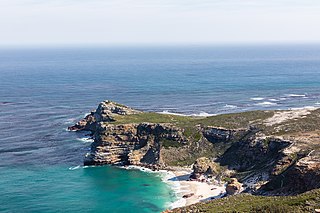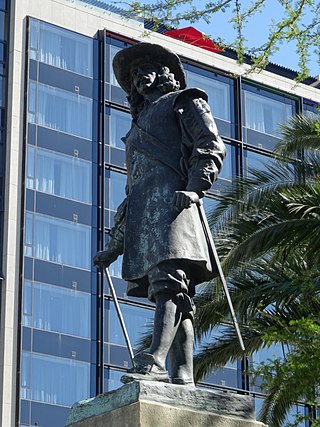
The Cape of Good Hope is a rocky headland on the Atlantic coast of the Cape Peninsula in South Africa.

Bartolomeu Dias was a Portuguese mariner and explorer. In 1488, he became the first European navigator to round the southern tip of Africa and to demonstrate that the most effective southward route for ships lies in the open ocean, well to the west of the African coast. His discoveries effectively established the sea route between Europe and Asia.

Table Bay is a natural bay on the Atlantic Ocean overlooked by Cape Town and is at the northern end of the Cape Peninsula, which stretches south to the Cape of Good Hope. It was named because it is dominated by the flat-topped Table Mountain.
The written history of the Cape Colony in what is now South Africa began when Portuguese navigator Bartolomeu Dias became the first modern European to round the Cape of Good Hope in 1488. In 1497, Vasco da Gama sailed along the whole coast of South Africa on his way to India, landed at St Helena Bay for 8 days, and made a detailed description of the area. The Portuguese, attracted by the riches of Asia, made no permanent settlement at the Cape Colony. However, the Dutch East India Company (VOC) settled the area as a location where vessels could restock water and provisions.

Mossel Bay is a harbour town of about 120,000 people on the Southern Cape of South Africa. It is an important tourism and farming region of the Western Cape Province. Mossel Bay lies 400 kilometres east of the country's seat of parliament, Cape Town, and 400 km west of Port Elizabeth, the largest city in the Eastern Cape. The older parts of the town occupy the north-facing side of the Cape St Blaize Peninsula, whilst the newer suburbs straddle the Peninsula and have spread eastwards along the sandy shore of the Bay.

Plettenberg Bay, nicknamed Plett, is the primary town of the Bitou Local Municipality in the Western Cape Province of South Africa. According to the census of 2001, the town had a population of 29,149. It was originally named Bahia Formosa by early Portuguese explorers and lies on South Africa's Garden Route 210 km from Port Elizabeth and about 600 km from Cape Town.
Pero Dias was a Portuguese explorer of the African coast. He accompanied his brothers Bartolomeu Dias and Diogo Dias on their journey around the Cape of Good Hope in 1487/1488, having commanded the supply with his brother Diogo. His voyage's original goal, however was only to reach the Cape of Good Hope as opposed to round it; however, when his ship was caught in a storm, they were blown around the Cape to the east side of Africa. Feeling they had already gone far enough, they returned to Europe.

The geography of North Africa has been reasonably well known among Europeans since classical antiquity in Greco-Roman geography. Northwest Africa was known as either Libya or Africa, while Egypt was considered part of Asia.
The area known today as Cape Town has no written history before it was first mentioned by Portuguese explorer Bartholomeu Dias in 1488. The German anthropologist Theophilus Hahn recorded that the original name of the area was '||Hui !Gais' – a toponym in the indigenous Khoi language meaning "where clouds gather."

A padrão is a stone pillar left by Portuguese maritime explorers in the 15th and 16th centuries to record significant landfalls and thereby establish primacy and possession. They were often placed on promontories and capes or at the mouths of major rivers. Early markers were simple wooden pillars or crosses but they deteriorated quickly in the tropical climate where they were often erected. Later, padrões were carved from stone in the form of a pillar surmounted by a cross and the royal coat of arms.

Portuguese maritime exploration resulted in the numerous territories and maritime routes recorded by the Portuguese as a result of their intensive maritime journeys during the 15th and 16th centuries. Portuguese sailors were at the vanguard of European exploration, chronicling and mapping the coasts of Africa and Asia, then known as the East Indies, and Canada and Brazil, in what came to be known as the Age of Discovery.

Robert Jacob Gordon was a Dutch explorer, soldier, artist, naturalist and linguist of Scottish descent.

Saldanha, also known as Saldanha Bay, is a town of 21,636 people, located 110 kilometres (70 mi) north of Cape Town on the northern shore of Saldanha Bay, in the Western Cape province of South Africa. Its situation as a natural sheltered harbour has led to development as a port for the export of iron ore from Sishen in the Northern Cape, which is transported on the Sishen–Saldanha railway line. The port is one of the largest exporting ports of ore in the whole of Africa, and it is able to handle ships as large as 200 000 tons deadweight.

The Bartolomeu Dias Museum Complex is the second biggest provincial museum affiliated to the Western Cape Department of Cultural Affairs and Sport in South Africa. It is located at Mossel Bay.

Vleesbaai, a seaside vacation town, situated between Mossel Bay and Gouritsmond in Western Cape, South Africa.

Portugal–South Africa relations refer to the current and historical relationship between Portugal and South Africa. Nowadays the two countries have solid relations, with South Africa representing a major partner for Portugal amongst AU members.
A Statue of Nelson Mandela was unveiled on 24 July 2018. It was placed on the balcony of Cape Town City Hall overlooking the Grand Parade, Cape Town, South Africa. Nelson Mandela was the first post-apartheid president of South Africa and received the Nobel Peace Prize in 1993

The statue of Jan van Riebeeck stands alongside the statue of Maria van Riebeeck on Heerengracht Street in Cape Town, South Africa. Both statues stand with their backs to the sea looking south to Table Mountain.

A statue of Maria van Riebeeck stands alongside that of her husband, Jan van Riebeeck, in a roundabout on Heerengracht Street in Cape Town, South Africa.















